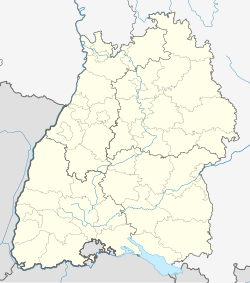
Schönbrunn is a municipality in the Rhein-Neckar district, Baden-Württemberg, Germany. It consists of the villages Allemühl, Haag, Moosbrunn, Schönbrunn and Schwanheim. It is situated in the southern part of the Odenwald hills, south of the river Neckar. Schönbrunn lies about 7 km southwest of Eberbach and 18 km east of Heidelberg.

Mudau is a municipality in the Neckar-Odenwald district, Baden-Württemberg, Germany. As of 2013 it has 4,833 inhabitants.
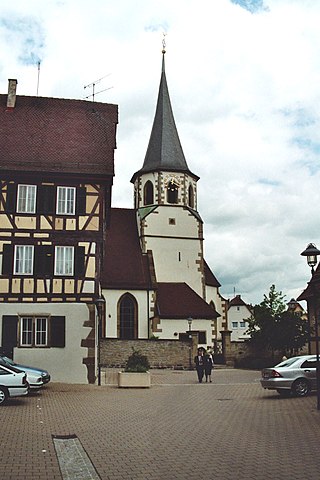
Illingen is a municipality in Baden-Württemberg, Germany. With a population of about 10,000, it is 27 kilometers (89,000 ft) to the west of Stuttgart, the capital of Baden-Württemberg.

Nußloch (help·info) is a municipality in the Rhein-Neckar-Kreis (Baden-Württemberg), about 10 km south of Heidelberg. It is on a much traveled tourist route: Bergstraße and Bertha Benz Memorial Route. The hamlet Maisbach also belongs to Nußloch.

Freudenberg is a town and a municipality in the district Main-Tauber-Kreis, in Baden-Württemberg, Germany. It is situated on the river Main and has a population around 3,700.

Eberbach is a town in Germany, in northern Baden-Württemberg, located 33 km east of Heidelberg. It belongs to the Rhein-Neckar-Kreis. Its sister cities are Ephrata, United States and Thonon-les-Bains, France.

Eppelheim is a city in northern Baden-Württemberg bordering Heidelberg. It belongs to the district Rhein-Neckar-Kreis.
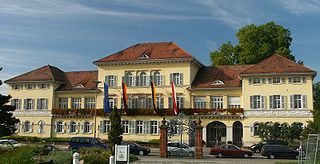
Edingen-Neckarhausen is a municipality in the district of Rhein-Neckar-Kreis, in Baden-Württemberg, Germany. It is situated on the left bank of the Neckar.
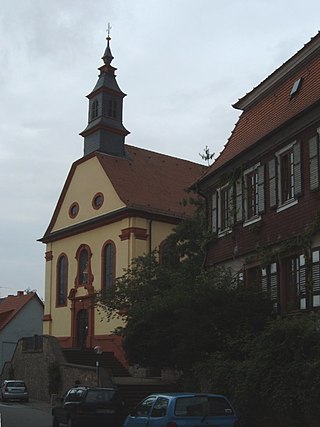
Hemsbach is a town with approximately 12,000 inhabitants in the Rhein-Neckar-Kreis of Baden-Württemberg, Germany. It belongs to the European Rhine-Neckar Metropolitan Region. It is situated on the Bergstraße, 18 km northeast of Mannheim. Hemsbach was twinned with Wareham, Dorset in the UK in 1986.

Mauer is a village in south western Germany. It is located between Heidelberg and Sinsheim in the Rhein-Neckar district in the state of Baden-Württemberg.
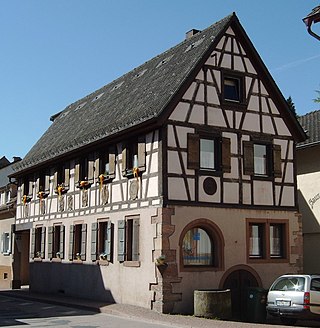
Schönau is a city with approximately 4400 inhabitants in the district of Rhein-Neckar-Kreis, in Baden-Württemberg, Germany. It is situated in the Odenwald hills, 10 km northeast of Heidelberg. Schönau Abbey is located here.

Zwingenberg is a village in the Neckar-Odenwald district, in Baden-Württemberg, Germany.

Bammental is a municipality in Rhein-Neckar Kreis of Baden-Württemberg.

Epfenbach is a municipality in south western Germany. It is located between Heidelberg and Sinsheim in the Rhein-Neckar district in the state of Baden-Württemberg. The municipality belongs to the municipal association of Waibstadt and the tourist region Brunnenregion.

Zuzenhausen is a municipality in Baden-Württemberg and is part of the Rhein-Neckar-Kreis.

Spechbach is a town in the district of Rhein-Neckar in Baden-Württemberg in Germany.

Wilhelmsfeld is a municipality in the Rhein-Neckar-Kreis of Baden-Württemberg in Germany.
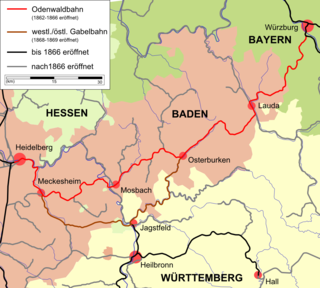
The Odenwald Railway was the name given to a Baden railway line in southwestern Germany built from between 1862 and 1866. It ran from Heidelberg via Neckargemünd and Meckesheim through the Little Odenwald mountains to Waibstadt, Mosbach, Osterburken and Lauda to Würzburg in Bavaria.
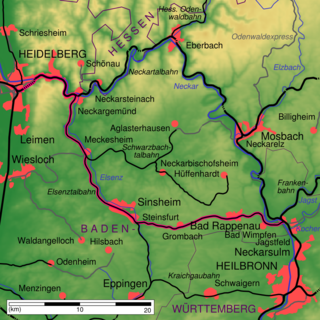
The Elsenz Valley Railway (Elsenztalbahn) or Neckargemünd–Bad Friedrichshall railway is an electrified, partly double-tracked main line in the German state of Baden-Württemberg, running from Heidelberg via Sinsheim to Bad Friedrichshall, that, for part of its course, follows the Elsenz river that gives it its name. The crossing stations on the single-tracked sections were controlled by mechanical signal boxes until 2008, but are now controlled by electronic interlockings.

The Kleiner Odenwald is the southern part of the central German hill range, the Odenwald, and is up to 567.8 m above sea level (NHN). It is also part of the natural region of Sandstein-Odenwald in the north of the state of Baden-Württemberg. Lying east-southeast of Heidelberg and south of the River Neckar, which separates the Kleiner Odenwald from the rest of the Odenwald, its landscape is shaped by the underlying sandstone that also dominates the northern Odenwald.




